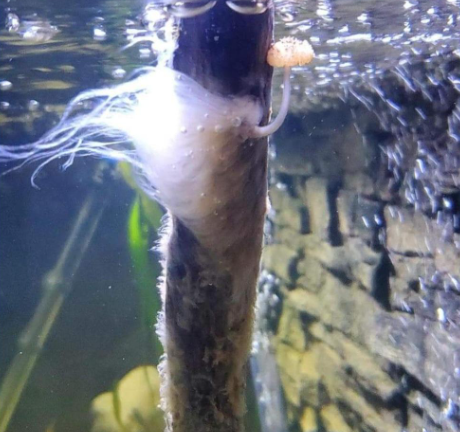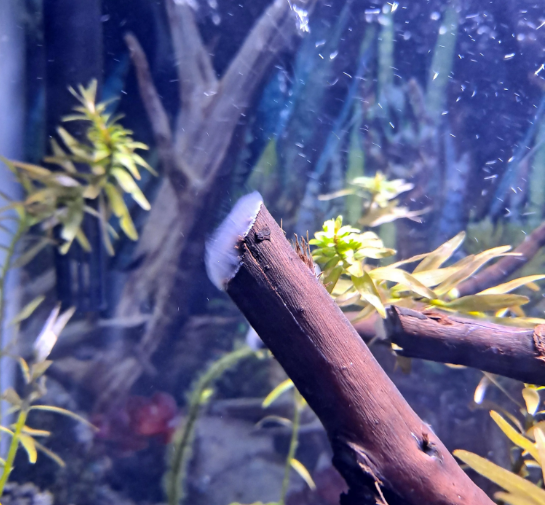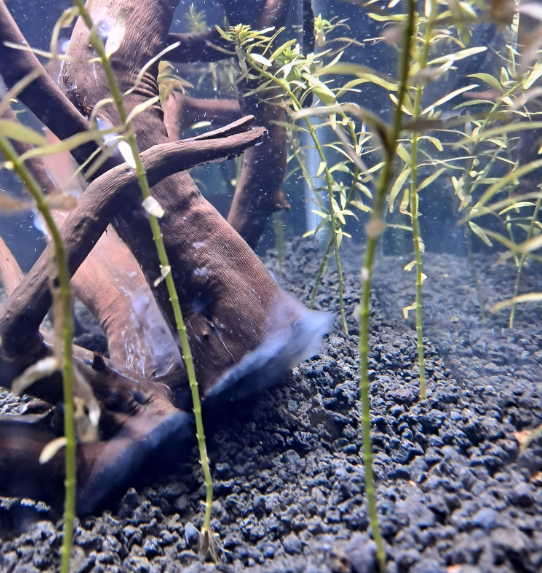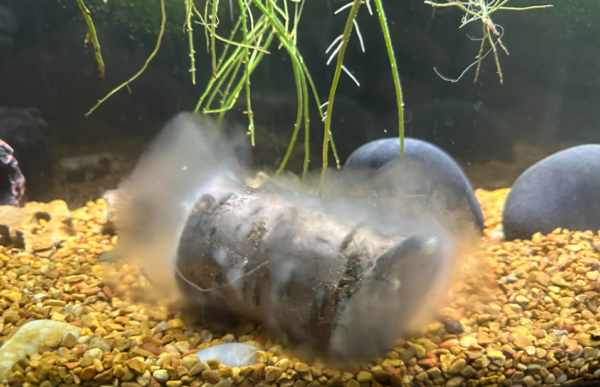A crystal-clear aquarium is a marvel that you can enjoy day and night, but imagine when your beautiful aquarium suddenly becomes covered in a slimy white residue that collects on the walls, plants, and fish. What do you do now?
Your problem is the typical “white mold in aquarium,” and you need to urgently take action to fight and remove it from your beautiful tank.
Here’s everything you need to know about treating white mold and preventing it for a clean tank.
Table of Contents
What Is White Mold in an Aquarium?
White mold is a type of fungus that spreads with microscopic spores. It can form in an aquarium when the conditions for its growth become favorable.
As soon as the conditions for its growth are met, it grows alarmingly. The fungus can grow on the walls of your aquarium, in the nooks and crannies of ornaments, on aquatic plants, on substrate, and on your fish.
Without treatment, you will have to start your aquarium from scratch as a new aquarium.
Signs of White Mold Formation in Your Aquarium
The obvious sign of white mold starting to infest your aquarium is the white or gray buildup on the surfaces of your aquarium. On your fish, it may show as white fluffy bits, usually around their eyes and gills. Your aquatic plants may develop a dull shine, which increases until they look gray or off-white.
The water in your tank may also become cloudy and dull as the fungal spores spread in it, making your whole tank look dingy and gray. Your fish will also start to look lethargic, and some may develop health challenges such as swim bladder.
White mold in your aquarium is serious, and you should take action immediately.
Causes of White Mold Formation in an Aquarium
Knowing what could cause the white mold in your tank is the start of ensuring you can treat it, remove it, and avoid getting it again. You want to ensure you never make your aquarium a favorable place for white mold to thrive again.
Here’s what causes white mold formation in an aquarium:
Soiled Water
Dirty aquarium water (specifically with loads of nitrates from fish food and waste) is an instant “open door” to fungal infections. The fungi thrive when there are loads of contaminated water from which to draw nutrients.
Poor Circulation
When your tank water stands still for too long, such as when your filter doesn’t pump enough or it’s too small, it creates dead spots of water where the oxygen levels drop. Combine this with contaminated water, and you have a happy recipe for fungi to find a foothold.
Excess Fish Food
You dirty the water when you feed your fish more than they can eat. Fish food is nutrient-dense, so it quickly increases ammonia, nitrates, and other elements in the water that boost the white mold’s growth needs.
A Trojan Horse
We’re not discussing a historical event here, but the principle is the same. You can introduce white mold when you add any new element (water, plants, substrate, ornaments, or fish) to your tank.
Like the legend, white mold can hide away on a seemingly harmless new addition to your aquarium and quickly contaminate your tank.
Steps to Prevent White Mold Formation in Your Aquarium
Of course, the best step to prevent white mold from forming in your aquarium is never to let it near your aquarium, but you should also take care not to give it the conditions needed to grow.
Here are some preventive steps to keep white mold out of your aquarium:
- Test the Water Parameters
Your tank water may look clean, but regular testing can help you quickly identify when the water parameters aren’t ideal for your fish. Likewise, water testing allows you to see when the water parameters are becoming hazardous quickly.
With testing strips, you can identify the volume of ammonia, nitrates, nitrites, and organic material in your tank. When you notice an increase in poor water parameters, take immediate steps to prevent white mold from forming.
- Regular Cleaning and Filtration
When the tank becomes soiled, it’s easier for the white mold spores to root and multiply. Cleaning your tank regularly and scraping your tank walls are the best ways to prevent white mold from taking hold.
Your tank’s fish and plants require effective filtration, but you should clean your filter to continue offering good filtration. A blocked filter is an ideal place for spores to root. Replacing filter material and regularly cleaning your filter is an excellent way to prevent mold formation.
- Strict Quarantine Protocols
When you’ve purchased new plants, fish, or decorative elements, it’s tempting to add them straight to your tank, but this is often the main reason white mold and other diseases enter your tank. You must quarantine new tank additions to ensure that invisible mold spores aren’t currently on them.
New fish should be added to a quarantine tank, and new plants should be rinsed thoroughly and quarantined for four to six weeks. If the fish show signs of illness or odd behavior, it could be a sign that they have been exposed to white mold spores or have another contagious disease.
Never add any new addition to your tank immediately (even if it’s a plastic plant in a sealed packet). Any surface can carry white mold spores, so rinse it first. Organic or living things need to be quarantined.
- Natural Remedies
If you suspect mold may begin to attach to your fish, you may need to use a chemical or medicinal treatment, but you can (and should) also add the correct volume of aquarium salt to your tank, according to the fish you keep.
A substantial water change (in some cases, even a 100% water change) can also prevent mold from forming (as soon as your water parameters go out of whack).
Removing White Mold in Your Fish Tank

Okay, you missed the signs, and your tank is suddenly white and slimy and has white mold growing all over. It’s a disaster, right? Nope, it’s still salvageable.
With the right treatment protocols, you can ensure you get all the mold under control and quickly reestablish your beautiful aquarium (mold-free). First, decide how serious the mold growth is and how extensively it’s spread.
Now, decide which of the following steps are needed to clean your tank of all-white mold:
General Cleaning
If the mold growth is less than 25% of your tank, it’s possible to implement the following measures to remove as much mold as possible without too much disruption to your aquarium. When mold no longer has ideal growing conditions, it will stop spreading and ultimately die.
- Water Change
Perform a water change with a larger volume than your usual 15-20% water change. Ensure you only add non-chlorinated water to replace the water you drain. If there’s still water clouding that happens, you can perform a water change every couple of days, even going so far as a 50% water change.
Check that the water added is at the same temperature, pH, and hardness as your tank water.
- Siphon Substrate
Siphon the substrate in your aquarium daily, removing as much organic material, fish wastes, and microparticles as possible. Removing these will reduce the nutrients that mold needs to survive and reproduce.
Learn more about siphons in our handy guide.
- Filter Cleaning
Clean the filter daily, replace filter pads as needed, and you may have to rinse filter balls and filter filament in water with 3% hydrogen peroxide before returning these to the filter. Of course, this does mean your filter may no longer offer biological filtration as your good bacteria colonies may perish. Luckily, you can replace these with store-bought filter bacteria.
- Scrape Sides
Use a cleaning kit to scrape the sides and remove any buildup or slimy residue that the white mold formed. To avoid cross-contamination, scrape from the bottom up, then wipe the scraper on a sterile rag or wipe. The goal is to remove mold deposits, not scrape them loose (which will spread the spores even faster).
- Remove Plants and Rinse
Remove your plants and rinse them in fresh water several times if they seem contaminated. In the worst cases, rinse them in water with a 3% hydrogen peroxide solution.
Cleaning the Filter
In cases of severe mold growth, you will have to decontaminate your entire tank, starting with your filter. You must remove the filter from the tank, empty all filter material, and disconnect all tubing.
Next, place the filter body and all filter tubing and components in a bucket with warm water and bleach or 6% hydrogen peroxide (never both). Let it soak for 20 minutes, then scrub with a soft brush. Rinse twice in clean, warm water.
Note on Tubing: If your filter’s tubing is older and yellowed, it won’t be easy to clean it thoroughly, so consider replacing the tubing with new tubing.
Allow to air dry.
Now, reassemble your filter with fresh filter material. You may reintroduce filtration bacteria using a store-bought product.
Substrate and Decoration Cleaning
Cleaning the aquarium substrate when your tank is heavily contaminated with white mold is a choice between replacing all the substrate with new substrate or removing the substrate and thoroughly rinsing it in warm water with a 6% hydrogen peroxide solution.
Decorations can be cleaned like the tank filter with a warm water soak, rinse, and air dry.
Fish Cleaning
Cleaning your fish can be challenging. You may need to remove them from the tank, place them in a smaller tank for quarantine, and administer an antifungal treatment. Adding aquarium salt to the quarantine tank is an excellent way to disinfect any raw spots on your fish and promote healing.
It’s poorly recommended to remove any white mold spots forcefully. Still, some aquarium hobbyists recommend placing your fish in a higher-solution saltwater bath for a few minutes to remove more fungi. Of course, this is not always safe and could harm some fish species, so take care if you decide to take this route.
Plant Cleaning
You must clean the plants in your aquarium of white mold and spores. If the plants have begun to rot, removing and discarding decaying plants may be advisable.
Still, healthy plants need to be rinsed with a mild saltwater solution or sprayed down with a heavily diluted hydrogen peroxide solution.
Pay special attention to the roots and growth nodes, where mold spores can lie in wait. Place the plants in a quarantine tank for four to six weeks to ensure no mold spores regrow.
FAQs
Monitor your aquarium for mold growth, and if you notice any signs of white mold, remove all white mold and take preventive steps. Scrape the tank sides, perform appropriate water changes, clean the filter and replace filter material, and add antifungal medicines to your tank.
Remove fish and place them in a quarantine tank. Clean plants, aquarium substrate, and decorations to prevent mold from reoccurring.
In extreme cases, disinfect the entire tank before adding fresh water, clean substrate, and then the fish and plants once the four to six-week quarantine has ended.
White mold can be detrimental to your fish if left untreated. Immediately treat white mold in your tank to ensure it doesn’t cause lesions on the fish, rot on plants, and unsightly growth on aquarium surfaces. White mold can lead to swim bladder, further fungal infections (such as ich), and disease.
Aquarium mold or white mold is a discoloration of the tank surfaces, fish, and plants from a mold or fungal infection. The mold spores cause the water to become cloudy or milky, while the spores create a slimy residue to the touch.
Eventually, the mold will form white fluffy strands and clusters when the mold colonies are mature.
Final White Mold Thoughts
Nobody likes to have any infection in their aquarium, but white mold can be tough to deal with if left untreated. The best solution is to inspect your aquarium frequently and test the water parameters often. Clean the tank filter, and never introduce new plants or fish to your aquarium without quarantining them for at least four to six weeks.
Wash your hands before handling your fish, their food, the plants, or performing maintenance on your tank. You can avoid your tank developing white or aquarium mold with the correct precautions. If the white mold has damaged the silicone in your aquarium, it may be time to scrape out the old and repair it with new silicone. Learn about the best and safest aquarium silicone in our guide.



